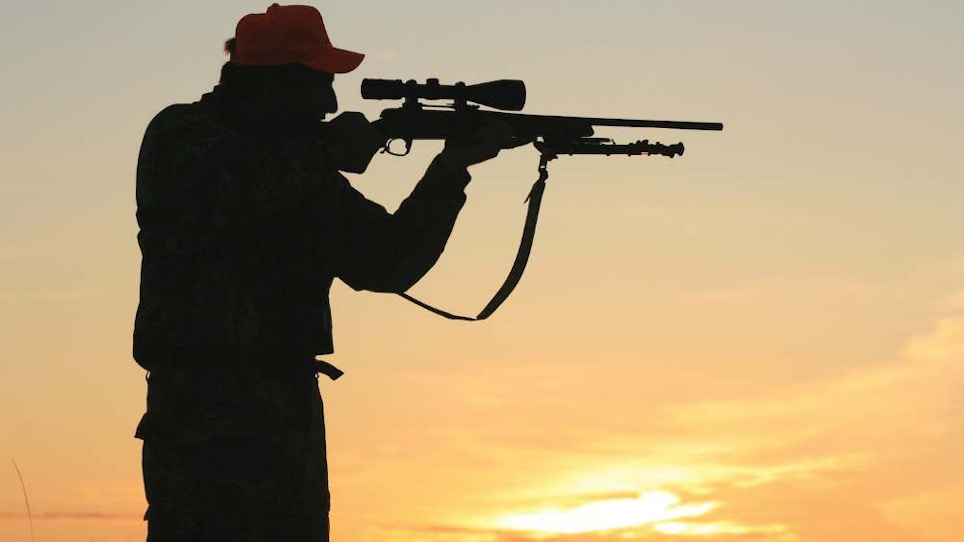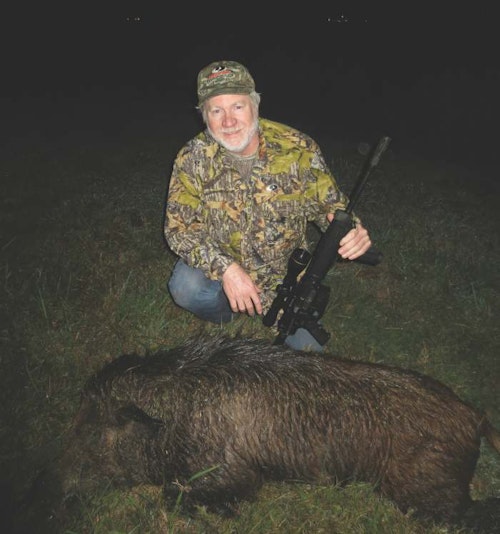
Practicing your shooting skills during daytime, dusk and nighttime can help when you get the opportunity to pursue predators and hogs. (Photo: Michael D. Faw)
The battery-powered light in my hand reflected off the raccoon’s eyes with a greenish hue. I pointed to where the masked bandit was lurking among the tree limbs overhead. It took numerous tries before my hunting partner saw that raccoon, and then he started wildly shooting with his .22 rifle.
Unfortunately, I could see his numerous shots were far misses as leaves and bark chips filled the air — in an area other than where the raccoon lurked. That raccoon, however, soon decided to take action and quickly moved to the back of the tree’s thick trunk, got out of sight and apparently jumped to another tree and got away unscathed.
It’s a fact: shooting at any target in the night brings many challenges. In addition to raccoons, many states permit hunting predators, including coyotes and bobcats, plus hogs after the sun sets. Shooting into the darkness is definitely not as easy as it’s portrayed on TV. There are many factors to successfully placed shots in the dark, and many problems that prevent dark-time accuracy.
To improve shots in the dark, you need to understand those many problems and challenges that darkness brings to the situation.
Whoa, It’s Dark!
First, there’s darkness. This lack of seeing everything around and before you can lead to tunnel vision, which the can then lead to incorrect — or a total lack of — depth perception. This is easy to understand. Without a firearm, simply walk to the back of your yard or behind your hunting cabin in the night, shine a light into the nearby fields or forest, and guess how far (in yards) it is to a seen object. Write the number down and note any things seen there that caught your attention.
Then, return the next day in daylight and take a look. Many hunters are shocked to learn something they thought was far away was only several yards away. Tunnel vision and depth perception are leading causes of missed shots in the dark, and being outside and shooting at night are ways to offset some of these problems. Depth perception misjudgment will never completely go away. You just need to understand it exists and try to compensate.
The more you are outdoors and hunting/shooting at night, the more familiar you become with night vision shortcomings. A huge factor is that because of rods and cones in everyone’s eyes, and the brain’s adjustments to what is perceived through the eyes, the same item seen by two individuals is perceived differently. Again, just being out there and being active at night is the best aid to understanding and helping your brain understand.
Next, there are sights and lights. Most sights on firearms work OK or marginally in good daylight, and fail miserably in the dark. Tritium sights seem to work better than most in darkness, and they actually glow in the dark. But sight brightness also can lead to confusion about where an object is and how the sights align. If you feel aligning rear sights, front sight and the target in daylight is a challenge, toss in some darkness and you have a real down-range dilemma.

If your firearm has a riflescope, or any scope, or a red dot sight or nearly any standard shooting optics that work well in daytime, many problems come into play in the dark. Seeing crosshairs can be nearly impossible with some scopes, and seeing a bright red circle can be blinding if set on the highest setting. At a minimum, you should be able to adjust the intensity of any red or green in the optics or you will face challenges.
The same goes for illuminated reticles. To make standard riflescopes work in the dark, you’ll need the thicker duplex reticles and to shine a light on the object to be engaged. Illuminated reticles and a system with thick crosshairs and a small red illuminated dot in the center offer benefits. Like all electronics used or mounted on your rifle or shotgun for night duty, check with your state’s game laws.
With laser sights, there is the problem of distance—and the distance from the muzzle to the target. Again, double check your state hunting regulations regarding hunting with laser sights and lights. Some states are OK, others frown. If you set a laser sight for 20 or 30 yards in the daylight and the target is 50 or 60 yards away at night, it could lead to a miss. The projected beam is straight in nearly all conditions, so the point of impact is where you set it to be. Any item closer or farther away could be shot over or under. Again, shooting at night on a regular basis can help you determine the best hold-over or adjustments for the system you hunt with.
Lights of all types (big and small, handheld and mounted to the firearm or your body) also can cause problems when hunting and shooting at night. Along with the tunnel vision and depth perception issues, there are lumen issues. Stated lumens on nearly all lights are for peak battery performance with fresh batteries, and that’s an optimal number. That number can drop very quickly. Every time the light is turned on, the battery loses power and the lumens output decreases. The change in light intensity and the resulting shadows can cause distortions and problems when hunting in the dark. Those distortions can be distracting or confusing.
Muzzle Blast
Another common problem with hunting at night is something never seen during daylight — muzzle blast. When the trigger is pulled, the powder burns and the bullet or shot flies out the muzzle. Behind it comes burning powder and gases — and a sometimes spectacular fireball. Shooting pistols chambered in .357 Mag., or rifles in .308 Win. or shotguns in 20 or 12 gauges will normally produce that blinding fireball in the dark. The fire can cause utter mass confusion with many shooters, especially when not anticipated. I once saw a shooter nearly drop a .357-chambered revolver when he shot in darkness because he thought the pistol had exploded. He was clearly rattled.
Just remember that fireball and muzzle flash is present — but unseen — during daylight. That’s why many shooters who place coats and shirts on car hoods have holes burned in the garment when shooting during daylight. The flame and burn are there. The proof is in the destroyed clothing or paint on the vehicle’s hood.
A final factor that contributes to failures in the dark is operator error. When shooting in daylight you can look down and see the selector switch on the side of a Modern Sporting Rifle or see the bolt-action handle or find the release button/tab on a pump gun. Those go missing in the dark and it is familiarity with the firearm that rules the operation.
When using a firearm that is not shot often, many problems arise because of the lack of familiarity. Game animals such as coyotes or bobcats can be long gone before the safety is discovered and disengaged or an action is operated. The best cure I know is to go outside frequently and operate the firearm’s action and safety mechanisms. Familiarity is the key to overcoming this operator error.
Darkness, as you can tell, is a problem maker on many levels. There is a solution to all of the fore mentioned problems. Practice and shoot often in the dark.
Defeating the Darkness
Now that the many problems created by darkness are understood, it’s time to find solutions. Those same lights and lasers that cause problems in the dark can also provide some benefits. You’ll have to weigh those problems against the benefits — and the costs.
Lights are a must have for hunting at night. Since you already have a rifle, a call and possibly a decoy in your hands, where does the light go? Either grow another arm and hand to assist you or attach the light to your head or the firearm being used.
I like the headband lights and there are many models that provide bright LED white light and red illumination. You just have to reach up and push a button. Same goes for cap clip-on lights. These small and powerful, plus affordable, lights often offer red, green or blue light options. The green and blue can often help with blood trailing if that chore pops up.
If you plan to spend numerous nights outdoors on the hunt, you may want invest in a quality rechargeable light. Now for a word of caution: There are quality lights available at great prices, then there are lights where you pay for a name, and there are lights that last about as long as it takes to open the package and insert the batteries.
For lights to mount on the firearm, there are buttons to push or pads to squeeze. There’s simply too many models to cover, but do note that if there’s a cord, you can bet when you are dashing through a laurel hell in the Appalachians to reach a treed hound, that cord connecting the light to the pad will be gone when you arrive at the dog—and the light will not work. There are many flashlights that are secured to the firearm with a clamp while shooting and removed to use as handheld while walking. You make the best selection and expect to pay several hundred dollars for a quality one.
A good rule of thumb is carry an extra light in your vest or daypack, plus batteries. The greater the distance you are from the truck, the more likely batteries will die and leave you stranded. I’ll toss one more suggestion into the dark, if you have an old Coleman white-gas burning lantern, consider taking it along. If you don’t have one, stop at yard sales and remember to buy the small mantles or globes that go inside. Nothing lights the night like one of these, so if you lose a pistol like one of my friends did while hunting at night, this light that turns dark into daylight saved the day — or that pistol recover effort.
While lighting the night is important, so is telling someone where to shoot and being certain they see or understand the target. You can spend several hundred dollars on a laser sight, or simply shop at the big box hardware stores and get a handheld laser pointer. Red could be easier to see at night when green leaves or grass are present, and many of these are small enough to fit in a shirt pocket. When you or someone in your group sees something like a raccoon perched on a limb, pointing with a laser pointer directs everyone’s eyes to the target.
Those Shots in the Dark
Last thing to consider when you have the lights and sights and are familiar with your hunting firearm, is to practice. Scout an area during the day, set up markers for safe lanes and boundaries and return to shoot at night. Choose your area to practice carefully because folks who would never call the law because they don’t want to get involved will now call law enforcement the minute they hear a gunshot in the dark.
Once you get experience shooting your firearm and its sight system in the dark, then that know-how helps when hunting at night. Now, watch your step because there are rocks and roots everywhere just waiting to trip you!





